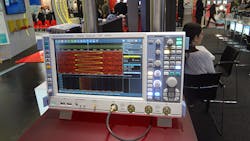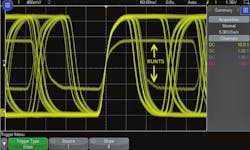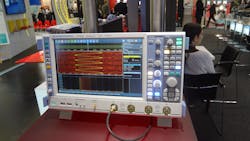Zone triggering is a feature found in high-end, high-speed oscilloscopes that has been available for a few years, and that many developers may not be aware of. It goes way beyond the conventional edge- or threshold-triggered approaches available on all scopes. It makes capture of infrequent anomalies much easier, especially for complex signals.
Zone triggering is easier to do with today’s touchscreen interfaces. Dragging a box around a signal is a quick way to block out desired region of interest. Some products allow different types of region and region construction. They can often be combined with other triggers, which is typical for more conventional triggering methods.
Johnnie Hancock, product manager at Keysight Technologies’ Oscilloscope Products Division, has a detailed write-up of the technology. One example presented is the “runt trigger” designed to capture a signal that does not reach an intended high or low logic level (Fig. 1).
Runt and zone triggering are typically easier to set up than more complex parametric trigger modes, although they are also useful, because of the graphical interfaces now available with oscilloscopes. Using a touch interface or a mouse to select regions is fast and more intuitive.
Zone triggering is available in Rohde & Schwarz’s RTO2000 oscilloscope (Fig. 2) that I saw recently at Embedded World 2016. One neat thing about the RTO2000 is that this feature also operates in the frequency domain, allowing it to trigger when a signal’s frequency moves into or out of a zone.
It is not easy staying abreast of the latest features, but it is worth the effort when they can significantly simplify development and diagnostic chores. Zone triggering is one of those features. It takes a fast scope with a sufficient update rate to catch infrequent signal anomalies, but at least zone triggering will make it possible to catch those glitches.
About the Author
William Wong Blog
Senior Content Director
Bill's latest articles are listed on this author page, William G. Wong.
Bill Wong covers Digital, Embedded, Systems and Software topics at Electronic Design. He writes a number of columns, including Lab Bench and alt.embedded, plus Bill's Workbench hands-on column. Bill is a Georgia Tech alumni with a B.S in Electrical Engineering and a master's degree in computer science for Rutgers, The State University of New Jersey.
He has written a dozen books and was the first Director of PC Labs at PC Magazine. He has worked in the computer and publication industry for almost 40 years and has been with Electronic Design since 2000. He helps run the Mercer Science and Engineering Fair in Mercer County, NJ.
- Check out more articles by Bill Wong on Electronic Design
- Bill Wong on Facebook
- @AltEmbedded on Twitter


